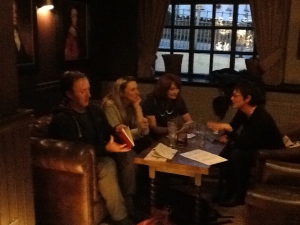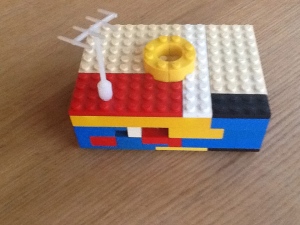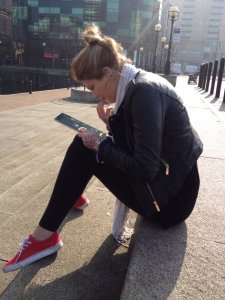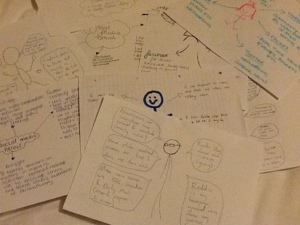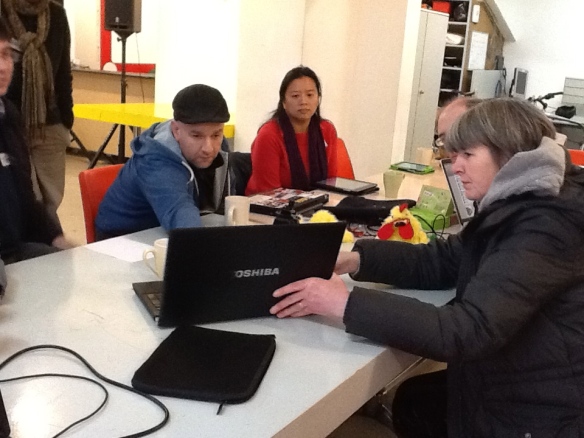This is a test
This blog has moved…..
Thank you for following this blog. I really do appreciate your interest.
I have now switched to a new address. If you’d like to continue to receive updates about my attempts to become a techy journalist, please click here and subscribe.
Liz
How Codecademy changed my life.

So I’ve just finished the HTML/CSS track of Codecademy and I’m left wondering how I’m going to fill my evenings now it’s over. I really enjoyed it – instantly practical and useful and I recommend it to all journalists!
But instead of twiddling my thumbs or spending my evenings watching endless episodes of Nordic Noir I decided to think about how Codecademy has changed my life. That’s not a flippant statement. It’s actually true. I first started it about eighteen months ago following the Javascript track. It opened my eyes onto a whole new world! Work commitments meant I didn’t complete the Javascript course (I started to flounder once we got onto OOP) and I do need to get back into it before I forget everything I ever learnt.
6 Ways Codecademy Changed my life
-
Evangelism
I realised how important this stuff was – not just for an old hack like me but for EVERYONE! It’s not boring and it’s not that hard. I started to think about how I could spread the word. What could I do to help other people who had never learnt how to code? What could I do to help my daughters learn to code because school wasn’t going to teach them?
-
 Pinterest board
Pinterest boardI made a Pinterest board of some of the resources I was finding as I voyaged round the internet looking for programming help for beginners. It’s got followers! Pinterest is a really great way to share resources – much more enticing than a list of hyperlinks, for example.
-
CodeClub
Doing Codecademy gave me the confidence to set up a CodeClub at my daughters’ primary school. I’ve got a couple of real experts on hand to help with the clever stuff but I think the children like the fact that I’m learning too.
-
Teaching my daughters
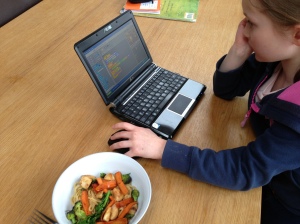 I’m not patient enough for home educating normally but some of my enthusiasm for learning to code has rubbed off on my daughters. This makes me very happy.
I’m not patient enough for home educating normally but some of my enthusiasm for learning to code has rubbed off on my daughters. This makes me very happy.Related Links
- Blogging
This blog has morphed from a blog about journalism education to a blog about learning to code and generally getting techy. I’m thinking about migrating to WordPress.org….. It’s got to be done, hasn’t it?? -
Journo-coders
I’ve become really interested in the rise of the journo-coder in newsrooms. Who are these people and how did they get to be this way? Should journalism departments at universities be doing more to create journo-coders?
Related Links
So those are a few thoughts about how I’ve changed since starting to teach myself code. I’d love to hear your stories too! Never, ever stop learning new stuff because it will open up surprising new doors and keep you away from the TV.
Networking with CodeClub
When I first got involved in CodeClub, I hadn’t expected to meet so many new people and become so involved in the “community.” Funny how things turn out…
We’ve managed to create quite an active group of CodeClub volunteers and wannabe volunteers in the Greater Manchester area thanks to the NW England Community Forum on the CodeClub website. It means we can stay in touch via email, share ideas and solve problems. It’s also a good resource for people who are keen to set up a CodeClub but need a bit more information/reassurance from people who’ve been there and done it (and literally got the t-shirt.)
Manchester Chamber of Commerce
We had our second meet-up on 8th May at the Manchester Chamber of Commerce. Thanks to Steven Flower for organising this. It was really interesting to meet such a range of people keen to get involved in setting up CodeClubs and I hope the “veteran volunteers” were helpful with their practical advice, personal experience and encouragement.
We chatted a bit about the HTML projects in Term 3 of CodeClub. One of the volunteers present had already piloted these and so had some useful advice to pass on. I’ll probably blog separately about this!

Alan Turing statue, Sackville Gardens, Manchester
© Copyright Stephen Richards and licensed for reuse under this Creative Commons Licence
So why were we meeting at the Chamber of Commerce? Manchester has a thriving digital/creative sector. It’s the original tech city, according to MIDAS, Manchester’s inward investment agency.
“Ever since we invented the computer, we’ve been fiddling about with it, designing, programming, creating content and sharing ideas.” (MIDAS)
That’s fantastic! But the industry is finding it hard to recruit people with the right digital skills. Matthew Kershaw, the Chamber representative for the Digital Infrastructure Group, told us there simply weren’t enough computer programmers in the Manchester workforce these days. That not only makes it difficult to fill vacancies, it inflates salaries making local digital companies less competitive.
The digital sector is so worried, its leaders have approached the Chamber of Commerce to ask for something to be done urgently. And they’re willing to throw money at the problem.
Their original suggestion was to put a Raspberry Pi in every classroom. On the face of it, this sounds fantastic – very now and a great photo opportunity! But then they thought about it a bit more. Hmm, what were schools going to do with these Pis? The Chamber realised that in most cases, the Pis would just be gathering dust in a corner of the classroom. Sad but probably true.
So Matthew Kershaw wanted to ask CodeClub volunteers for our ideas! As enthusiasts already working in primary schools, could we suggest equipment that would help kickstart a knowledge of computing in the next generation? We threw around a few thoughts but eventually reached a very different conclusion. It’s nothing to do with equipment. Most schools have access to computers. The problem is, they don’t know what to do with them.
What primary schools lack are the skills and confidence to use the computers they have to teach children to code. If Manchester’s digital sector wants to do something about that, it needs to put people into schools, not raspberry pis.
This is something the Chamber had already started work on so we were on very fertile ground here. We discussed encouraging companies to allow their employees to take time off work to volunteer at CodeClubs. We talked about promoting CodeClub to their members. The Chamber already has many school governors amongst its membership so this could be a great resource to tap in to. Perhaps members would prefer to volunteer at the weekend? CodeClubs can now be set up in libraries and other community centres so that needs to be publicised.
So, everyone left with plenty to think about. We need to keep in contact with the Chamber to see what help we can offer. Perhaps a video of volunteers’ testimony would be a good way of promoting the idea to digital companies…..(that’s the subject of yet another blog post, I suspect.)
Silicon Goyt Valley
Just a week after the Chamber of Commerce meeting, I was at the local pub with the volunteers from our Mellor/Marple Bridge CodeClubs. Thanks to Steve Kay for organising this.
We currently have CodeClubs at at least two schools in our tiny area so we’re fast becoming a programming hub!
One of our main discussion points was what happens to our CodeClub children once they get to the local secondary school? Will there be anything there to develop the skills they’ve learnt in Year 6? We’re going to get in contact with the ICT head at the secondary school to find out more. For example, could they set up their own CodeClub?
We also talked about a joint coding activity so we’re trying to encourage as many of our CodeClub members as possible to go to the next CoderDojo at Manchester’s MadLab. I produced some flyers about it to thrust into parents’ hands. No idea if any of them will turn up….
“Make a difference”
What I loved about both these meetings was that CodeClub volunteers don’t just talk about their own clubs, projects, problems etc (although we do do a lot of that!). They talk about the Big Picture beyond their immediate school. They see themselves as part of a mission, if you like, to give more and more young children the opportunity to learn these skills. They want to make a difference in the wider community and they have the ideas and commitment to do this.
So if you’re already a volunteer, I really do recommend getting together with other volunteers in your area and seeing what you can come up with. It’s great to have the support network around you when you come against problems or when you’ve hit a stumbling block.
There are rumours that CodeClub may be going global. So maybe for future meet-ups we’ll need to remember our passports!

© Copyright Byrev (Emilian Robert Vicol) on Pixabay and licensed for reuse under this Creative Commons Licence
Related Links
Raspberry Pi with a dollop of Lego
Pimp my Pi!
When it comes to making a case for your Raspberry Pi, Lego is really the only way to go. I didn’t have the heart to use my daughters’ shiny, girly pink Lego bricks for this, so we dug out my husband’s Lego from the cellar.
Vintage Lego
We worked out that some of this Lego is FIFTY YEARS OLD, inherited from an older cousin! Some of it’s a bit discoloured but on the whole it’s in great condition and felt somehow “right” for styling a Raspberry Pi.
This is what we came up with. The yellow fruit Polo thing is decorative but also structural.
Note the subtle modification to make it WiFi. Saves clogging up another USB port.
It got quite a few retweets on Twitter but there was some disappointing scepticism….
@lizhannaford Erm, I’m not sure that will work. 🙂
— (@mk7u) May 11, 2013
Centre for Computing History
So I started thinking about the combination of 50 year old Lego and brand new Raspberry Pi computing technology. What was happening in computing fifty years ago when this Lego was being forged in a Danish furnace?
An internet search brought me to the Centre for Computing History. It will be opening to the public in July 2013 in Cambridge but in the meantime its website is full of useful information such as a Computing History Timeline. Cool!
So let’s choose 1963…
- Douglas Engelbart invents the Mouse
- The first edition of the ASCII Standard was published
- Theodore H (Ted) Nelson coins the phrase Hypertext
I hope you’ll explore those links.
And it’s worth pointing out that you’d have needed far more Lego bricks to encase your computer back then….
Related Blog posts
My seven year old daughter’s first ever CoderDojo – at Manchester’s MadLab
“I just want to make a horse riding game!”

Just being in Manchester’s Northern Quarter is exciting. It’s very different from our little village!
That was Isobel’s plan for her first CoderDojo on 7th April 2013. I just wanted her to enjoy it and didn’t expect her to learn much on her first visit. I thought she’d just be testing the waters, having a look around, seeing if there were other girls her age there (very important when you’re seven).
So we decided to make a day of it. The CoderDojo is at the MadLab, right in the heart of Manchester’s Northern Quarter so just wandering around was a bit of an adventure.
Making Scratch Friends
It was busy and chaotic at the beginning in the best way possible. Isobel hooked up with a couple of other girls her age who are old hands at CoderDojo. They joined a Scratch group aimed at the younger children. It was led by the fabulous, inspiring, endlessly patient DJ Adams who came up with an idea to write a program that would take the monotony out of Times Tables. They all thought this was a much-needed tool!

The perfect preparation for a first CoderDojo. Home Sweet Home cafe is almost opposite MadLab (it’s the one with the green shutters) and the milkshakes are delicious!
With a mix of gentle questioning, allowing the older children to use their knowledge and experience, he took the group through the process step by step. Isobel’s new friends helped her out a couple of times which made it all the more sociable. It was just lovely to see such young children completely engrossed in a problem-solving task together.
New Challenges
Wouldn’t it be great if they could do stuff like this in ICT classes in school? I’d love to see teachers being able to pick up something from elsewhere in the curriculum (times tables is a good example) and then exploring it in a computer class.
Even better, after DJ had finished, the girls started chatting about how they could make the times tables program even better! Could they get the monkey to move its mouth? Could he explode at the end?! DJ set Isobel a challenge – could she get the monkey to put its arms out when the answer was even and down when the answer was odd. That got her thinking….
The Banana Piano
So much interesting stuff going on all over the CoderDojo! Isobel’s new friends dragged her over to see Steven Flower – the organiser of under-18 events at MadLab – make a piano out of bananas.
Yeeaaah, the banana piano is good, but Isobel just wanted to get back to her program so she could work on getting the monkey to react to odd and even numbers. She’s still not sure how to do it but knows she has to make another “costume” for the monkey sprite so gets to work on that.
Eureka!
Another wonderfully generous, patient mentor talks Isobel through the modulo operator. Suddenly, she sees a way of solving the challenge. It’s exciting for both of us – but it’s time to leave.
She wants to work on it on the train home. I draw the line!
But as soon as we get home…..
Nothing was more important to Isobel than fixing that program! She still needed guidance to get it to work and it took a lot of trial and error. But she got there in the end.
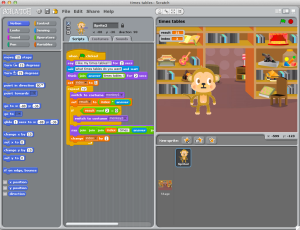
We did NOT make a horse riding game!
For me, that was the biggest achievement. I saw a different side to my daughter. Who’d have thought she could be so passionate about something which doesn’t involve writing a story (about ponies, usually)?
I met lots of familiar faces at CoderDojo, met new people whom I hope to see again and I came away with lots of new ideas for our CodeClub. Sadly, we won’t be able to go to the next CoderDojo because it clashes with the Mellor March – the big annual charity event in our village. But we will be back!
And finally, I’d like to say thank you to all the wonderful mentors who make CoderDojo such a fantastic experience for children and their parents. I’m very grateful.
Mobile Reporting exercise using Soundcloud, smartphones and Storify
This is a class project I worked on with first year Journalism undergraduates at Salford University, MediaCityUK. It was part of their Digital Journalism module. There are four groups each with about 15-20 students. My aim was to get them to explore audio recording on their smartphones/iPads and to create digital stories using curation techniques.
Choosing a story
Every week, students complain about the bus service which goes from the main university campus to our MediaCityUK building. It’s free to students on the stretch between the two campuses but it’s unreliable, they tell me. It’s a frequent reason they give me for being late to class! So let’s turn a negative into a positive and use this as the basis for our mobile reporting class.
The Tools
Most students in the class have smartphones or iPads – certainly enough to make this exercise work. Not many have done any serious audio work with them though so there are plenty of learning opportunities here. I’m indebted to Mark Settle at the BBC College of Journalism who specialises in smartphone reporting. His video tutorial on recording audio came out the day after this exercise so it was pretty timely! But my favourite tip came from Nick Garnett, a BBC 5Live reporter. He’s a bit of a pioneer when it comes to iPhone reporting and has pretty much ditched other recording equipment. His blog about his experiments and discoveries is incredibly useful. I’ve always been worried about using the internal mic on the iPhone for serious audio recording because it’s so prone to wind noise but I’m yet to find the perfect external mic solution. His tip is simple – an ordinary windshield on the microphone end of the iPhone!
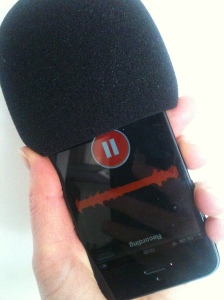 See my twitter conversation with him about this. So I bought one the day before my first session with the students so I could get them to experiment for me. £4.49 in Maplins!
See my twitter conversation with him about this. So I bought one the day before my first session with the students so I could get them to experiment for me. £4.49 in Maplins!
Most students already use Soundcloud for sharing and searching music so this seemed like a good place to start. I set up an account for all our students to use and gave them a quick demo in class, including the simple “top and tail” editing facility. I told them to save their audio as private. Not everybody had devices or 3G but so long as 5 or 6 in the class had it, we were OK. I also showed them Voddio in case some of them were feeling ambitious and wanted to do some proper editing and mixing on the go. Nobody did but that’s probably because you need to pay £6.99 to get the sharing/sending facility on Voddio.
The final element was Storify. I love Storify and was really keen to introduce it to my students! Again, I set up an account for the class to use and gave a quick demo. Storify is not perfect and sometimes it doesn’t hook up to Twitter as it should. We had some issues with it in the first two sessions but found a workaround. It was fine the following day with the other two groups. I know some people have given up with Storify completely because of its problems. I’m sticking with it because, when it does all work, it opens up so many creative opportunities for storytelling and engaging. Great teaching tool too.
The Task
I asked three students in each group to volunteer to man our digital newsroom (an ordinary classroom with PCs). There was no shortage of volunteers, I’m pleased to report! Everybody else teamed up into reporting teams – mostly pairs but some slightly bigger groups. We decided which aspects of the story we were interested in and what kind of audio material we wanted.
The newsroom team then took charge of deploying their reporters with additional instructions to take photos and tweet information.
Once the reporters were despatched, I briefed the newsroom team in more detail. I gave more instruction on Storify but, to be honest, they didn’t really need it. We talked about what makes good curation. Again, credit here to Mu Lin at Georgian Court University, New Jersey for putting together some guidelines. Basically, don’t drag and dump; provide context and background; have a structure; be selective.
One student specifically looked after the Soundcloud material once that started coming through. They listened through to all the material and made public the ones which were good enough for our story. They then alerted the Storify editor to the availability of the material.
I also wanted the newsroom team to use social media to engage the broader student community which also relies on this bus service. Could they get people outside this exercise to contribute to the debate? They came up with the hashtag #50busprobs.
Once the exercise was over and everybody was back in the classroom, the newsroom team briefed the reporters on what they’d been doing. we published the stories and explained the “notify” option on Storify.
I encouraged students to embed/export the Storify to their personal blogs and add a paragraph about their own contribution and analysis of the task. This was not assessed.
The Outcome
You can see an example of the stories created by students here just to give you a flavour of what they were able to do in the limited time (about 75 minutes).
The newsroom team worked really hard to engage with the broader community with some success. Maybe we should have started doing this in the week before the exercise to build momentum.
Working with Storify was great. It’s a really intuitive tool for building digital stories quickly. The students picked up the concept of curation v drag ‘n’ dump really well. They worked together to find relevant background context and structure whilst they waited for the audio material to come in from the field.
The students assigned to editing the Soundcloud material quickly worked out what kind of material would work best in a digital story. They also made sure to add titles and, in most cases, relevant photos to each Soundcloud to maximise their visual impact on the final story.
The reporters in the field all managed to find interesting audio material and get it back to the newsroom. We also got lots of really useful photographic evidence of buses standing idle round the corner rather then en route! All students reported finding Soundcloud easy and fun to use.
Some students has borrowed my windshield to experiment with. Apart from one group which had put it on the wrong end (!! my fault. I should have showed them), they reported good results
Evaluation
The students loved Storify and several of them went away and experimented with it on their own. Really pleased about this!
@lizhannaford it’s so user friendly, lovely alternative to #Wordpress and feels more colourful and ‘alive’I am a new fan;) #storify
— Taaliah Nazar (@Taaliah76) March 5, 2013
One student said she’d have liked longer for the exercise so that we could have rotated roles. I agree but on the plus side, she said she’d go and experiment with Storify on her own which is a good outcome!
Overall, the audio quality needed some work. That was mainly down to lack of editing. They needed to be ruthless with their material! This is largely my fault for not emphasising enough the need to edit BEFORE uploading the material. But on the plus side there was a great range of material and creative use of the medium. They definitely used audio to enhance our appreciation of the story.
Interestingly, the students doubted they’d be taken seriously with an iPhone as opposed to a “professional” recording device. That’s at odds with the professionals’ view. I suspect it will change as iPhones become a more acceptable part of the broadcast industry. Watch this space!
Conclusion
This was a fun exercise and I would definitely do it again. There is so much learning and thinking involved. The tools worked well. They’re free and easy to learn and use straightaway so everyone benefits.
We were lucky with the weather on both days – bright and sunny with minimal wind. I’m not sure how much we would have got done in more typical MediacityUK weather (howling wind, rain, cold)
Recording audio with iPhone – tips from the pro!
How do you teach Twitter?
I’ve spent a lot of time this past week trying to find ways to show people how Twitter can make their work life easier/simpler/more fun. I’m not sure how succesful I’ve been. Social Media is a drip drip process that has to be worked on. You can’t become an aficionado overnight. But here are a few thoughts.
The Social Tweeter
I got the first year undergraduate students in my Digital Journalism class to create their Social Media portraits so I could get a better idea of how they use different platforms – if at all.
The vast majority use Social Media a lot, mainly Facebook, Twitter and YouTube. But they’re using it almost exclusively to keep in touch with friends and follow celebrity news (it’s not called SOCIAL media for nothing.)
A few of them are blogging or following other people’s blogs.
Soundcloud is quite popular for sharing music they’ve made and finding other people’s music. There were one or two Pinterest users who said they liked finding cute DIY ideas they’ll never use!! There was also one Reddit fan.
There were a few who didn’t have a Twitter account or who did have one “but then realised they didn’t need it.”
So the task is to get these students to realise they already have the skills and experience (in most cases) to use social media like a real journalist. What they now need to do is crank it up a bit and find out how they can use social media in a more sophisticated, more professional way. But it’s hard getting people to turn their favourite social platforms into yet another work thing!
I decided to try to amaze them with the power of Twitter as a search tool! Don’t just google “Salford” when you want a story idea or an interviewee. See how much deeper you can get with a really well filtered Twitter search! So I started by showing them a few of my favourites – Followerwonk which is a great way to search Twitter bios, Listorious, a useful people search and list directory and Trendsmap which is a fun way to search local Twitter trends. Then I hit them with the big one – search operators! This was totally new information for every single one of them. They had no idea you could interrogate twitter so closely. I handed out copies of the list of operators (one between two to encourage collaboration) and then gave them some Twitter Tasks to perform. It’s based loosely on Sarah Marshall’s MozFest social media training session but I’ve simplified it into a bite-sized chunk which I think works better with students who may need a bit of convincing about all this kind of stuff.
The tasks gave the more advanced Twitter users plenty to keep them busy whilst I went round to each individual student (I had about 17 in each class) starting with the ones who were less experienced. The social media self-portraits were really useful in finding out who might need a bit more support early on and who would be able to work through the tasks independently. I was able to spend a few minutes with each student getting them started, answering specific questions, gently encouraging. I made sure to explain to them how these techniques could help in real journalistic scenarios and, crucially, help them get their assessments done.
Interrogating Twitter in this way really was a revelation to them so it was great fun for me to be able to share this stuff.
My colleague, Alex Fenton, who shares the teaching on this module, used another approach with the class the following week. He got them all to send out one tweet using our module hashtag #DigiJourno. Even this was new to some of the students. They were encouraged to retweet the most interesting/relevant ones. Again, it was a nice, bite-sized chunk of Twitter that slotted into the theme of the session without overloading anyone. It’s very easy to put people off Twitter for life by drowning them in information! I’d tried to introduce lists and Tweetdeck but that was probably a step too far at this stage and was definitely off-putting to some in the class – although the more adept twitter users immediately saw the benefits.
And it was a revelation to the students to find themselves in a university class where you were actively encouraged to spend time tweeting!!
The Reluctant Tweeter
Away from university, I found myself discussing twitter on two separate occasions last week with friends who work in the media making radio programmes (not news programmes so they wouldn’t describe themselves as journalists). Both had had bad experiences with twitter. One had been ordered to tweet by a manager but there was no thought-out strategy to this so the producer was left confused about the aim of the tweeting. She’d missed the one training session available. The other friend had been on a training session but it had seemed boring and irrelevant. Unsurprisingly, they both felt very negative about twitter and saw it as an extra workload being imposed on them.
The upshot of these conversations is that one of the friends is coming round for coffee one evening next week and I’m going to try to persuade her that it’s worth giving Twitter a second chance. Again, I think advanced search is the way to her heart. Show her how Twitter can help her find fantastic programme guests then all the rest will follow! You’ve got to make it relevant to people’s work life otherwise they just see it as an extra, time-consuming task they just don’t want to do.
I am genuinely excited by this challenge! I’ll let you know if I win her over. Then I’ll use that success story to work on Friend #2. Ideally, I want to spend a day at work with her putting her favourite contacts into Twitter lists…..
If you have any tips for teaching Twitter, I’d love to hear from you.
CodeClub in Manchester: Bringing it all back home
Manchester has a pretty good track record when it comes to computing so it seems like the perfect city for CodeClub to thrive. There’s just so much talent here! And I say this as a Scouser…
So today CodeClub volunteers and enthusiasts from around the Greater Manchester area got together at the fabulous MadLab in Manchester’s Northern Quarter. Some of us already knew each other either in Real Life (they’d visited our CodeClub in Mellor) or through Twitter or the NW community forum on the CodeClub website.
What we discussed
It was all very informal. Anne (my fellow Mellor volunteer) and I talked about our experience setting up CodeClub and answered questions about how to go about it and how the projects work. The CodeClub website is a bit sparse on these details and this can make it all seem quite daunting. In my experience, it was really useful to reach out to other CodeClub volunteers around the country to pick their brains. But ultimately, every school is different so you do just have to take a leap of faith and accept there’ll be a few niggles along the way. But I think it’s good that we now have this little supportive community to help each other out and share experience.
It was really interesting to hear how other people had got involved and why we were so committed to giving up our time to this project!
Next Step
We definitely want to meet again! We only scraped the surface today by the time we’d introduced ourselves. We want to talk about how we can spread the word to other schools or encourage more developers to get involved.
But CodeClub is only the starting point. The group of volunteers in MadLab today had so many good contacts/ideas/projects they were already working on which all tie in with the CodeClub ideals. For example, Steven Flower – who kindly set up today’s meeting -organises U18 events at MadLab and is involved in Young Rewired State and CoderDojos. I’d love to encourage some of our CodeClub kids to come along to a big event like that. And my daughters too!
We also loved this cheeky chap….
He’d hitched a ride with Dr Andrew Robinson from the University of Manchester who has been doing great work promoting fun projects using Raspberry Pi. His tweeting chicken even caught the attention of ITV news! He’s been writing worksheets to help children build these projects themselves and there’s a whole set of YouTube videos which are really fun to watch (Disclaimer- no hamsters were harmed during these demos, Andrew says 🙂 He’s also taken these projects into schools.
To be honest, it’s beyond my capabilities (unless I devoted a SERIOUS amount of time which I just haven’t got) but I’m really hoping my far cleverer fellow volunteers at Mellor would enjoy taking CodeClub in this sort of direction in future. The first step would be to encourage the children to attend events at MadLab where this kind of fun stuff is available to play with. The second step would be to arrange sessions to train volunteers how to do something simple with, say, the robotic chicken. They could then have the confidence to try it out with their own CodeClubs.
DJ Adams did a great job noting down web resources for all the different stuff we discussed and he’s started a Delicious list with it all which should be a useful resource. Thanks, DJ!
Maybe we’re being a little ambitious but that’s no bad thing. We’ve got a lot of catching up to do if we’re to create a new generation of computer programmers. And if we can’t do it in Manchester, then where else?


